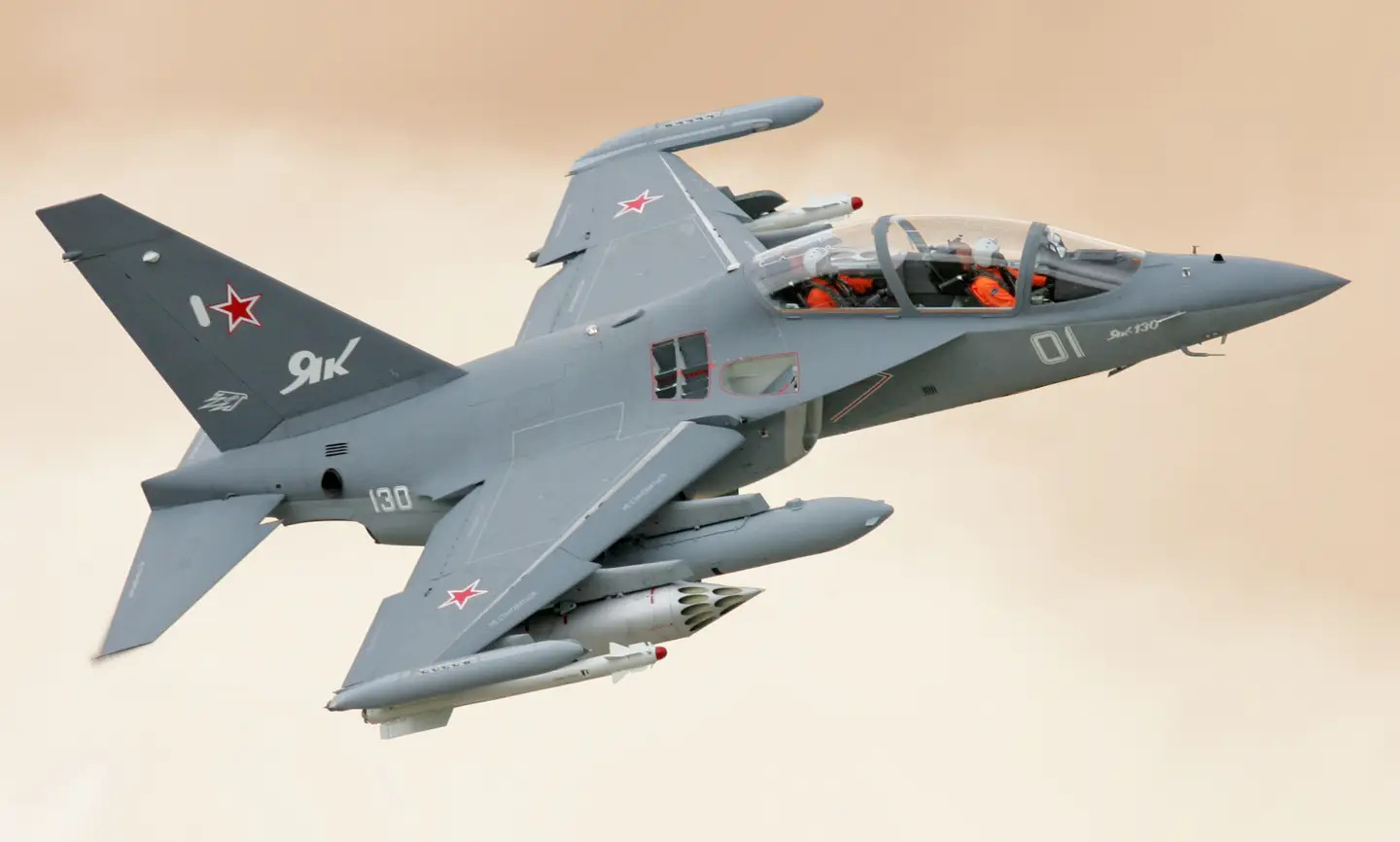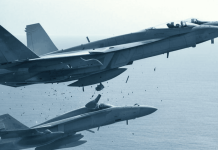The Russian aerospace industry has made significant strides with the unveiling of the Yak-130M, an upgraded version of the Yak-130 light combat training aircraft, at the Army-2024 forum.
Rostec’s Yakovlev Aviation Plant showcased this modernized aircraft, which is already in production at the Irkutsk Aviation Plant.
Yak-130-M: Enhanced Combat Capabilities
The enhanced version, named the Yak-130M, focuses on significantly expanding the combat capabilities of the original Yak-130 by integrating advanced targeting systems. Dmitry Popov, the aircraft’s Deputy Chief Designer, shared these updates in an interview with Izvestia, a Russian news outlet.
The upgraded systems include the BRLS-130R onboard radar station, the SOLT-130K optical-laser thermal television system, the President-S130 onboard defense system, and the KSS-130 communications system.
The Yak-130M is designed with a maximum take-off weight of 10,290 kg and can carry a combat load of up to 2,500 kg distributed across nine suspension points.
Engine upgrades have also been a priority for the Yak-130M. The aircraft is powered by two AI-222-25 turbofan engines, each delivering a maximum thrust of 2,500 kgf. These engines enhance the aircraft’s thrust and fuel efficiency, contributing to its high performance and extended operational range.
Additionally, engineers are also expanding the aircraft’s weaponry, incorporating four more gun pods under the wings and various holders that enable the Yak-130M to carry up to 16 bombs weighing 100 kg each.
This modification also allows for the deployment of satellite and laser-guided weapons. The Yak-130M now supports a broader range of armaments, including guided and unguided bombs, air-to-air missiles, and air-to-ground missiles, making it versatile for a wide array of combat missions.
Aircraft Specifications
The Yak-130M measures 11.49 meters in length, 4.64 meters in height, and has a wingspan of 9.85 meters. It can reach a maximum speed of 950 km/h, achieve a practical ceiling of 12,500 meters, and has a flight range of 1,610 kilometers, extendable to 2,265 kilometers with external fuel tanks.
According to Popov, the project, commissioned by Russia’s Ministry of Industry and Trade, has completed design documentation for prototype production. While he did not specify the aircraft’s release date, he mentioned that “prototypes and components are currently being assembled at the Irkutsk aviation factory.” Rostec plans to build three prototype aircraft for testing.
Trainer As Well As Light Fighter
The Yakovlev Yak-130, the predecessor to the Yak-130M, was developed as an advanced jet trainer and light combat aircraft. Originally a joint project with Italy’s Aermacchi, it was designed to train pilots for 4th—and 5th-generation fighters like the Su-30 and MiG-29.
First flown in 1996 and entering Russian service in 2009, the Yak-130 replicates the flight characteristics of modern fighters, featuring a digital cockpit and fly-by-wire controls. It can operate from various runways and, despite being subsonic, offers a cost-effective solution for smaller air forces requiring both training and combat capabilities.
Today, the Yak-130 is the most advanced trainer in service with the Russian Aerospace Forces. It was designed to replace outdated Soviet-era trainers. It provides both basic and advanced training for future front-line pilots, with capabilities for air-to-air and air-to-ground combat.
Last month, the Russian Aerospace Forces received a new batch of Yak-130 advanced trainers from the Irkutsk Aviation Plant of the United Aircraft Corporation (part of Rostec).
The exact number of units in this batch has not been disclosed. The previous delivery occurred in December 2023, when an unspecified number of Yak-130s and Su-30SM2 fighter-bombers were handed over.

Yak-130M Eyes International Markets
Like the Su-75 (Checkmate), the Yak-130 was conceived with export potential but has seen more success. The Russian Air Force is its primary operator, using it for pilot training and light attack missions. Other operators include the air forces of Algeria, Belarus, Bangladesh, Myanmar, Laos, and Syria.
Rostec has positioned the Yak-130M primarily for export markets, targeting countries seeking cost-effective alternatives to heavier aircraft. The project considers feedback from existing operators and is designed with the export market in mind, targeting potential clients in South America, East Asia, and expanded BRICS countries.
Russia is also considering further upgrades, like in-flight refueling capabilities, to enhance the Yak-130’s operational range.
Iranian Delegation In Russia
The Army-2024 forum showcased advanced models and unique innovations from the Russian military-industrial complex (MIC). Leading companies from the domestic defense industry presented around 1,500 products.
According to the Russian Defense Ministry, approximately 110 official military delegations and foreign companies participated in the event.
Iran notably took part in the forum, with its military delegation led by Brigadier General Ali Shadmani, Deputy Coordinator of the Khatam al-Anbiya Base. The delegation traveled to Russia to represent Iran.
As part of its deterrence strategy, the Islamic Republic of Iran exhibited a range of its defense industry capabilities at the forum. The Iranian exhibit, featuring contributions from both the Ministry of Defense and Iranian knowledge-based companies, showcased weapons, ammunition, drones, aviation equipment, air and maritime defense systems, ballistic missiles, radar and electronic warfare equipment, and industrial and military batteries developed by Iranian experts. A top Russian security official visited Iran’s pavilion at the Army-2024 forum.
It’s worth noting that in April 2023, Iran received an undisclosed number of Yakovlev Yak-130 ‘Mitten’ advanced jet trainers and light attack aircraft from Russia.
Amid the ongoing Russia-Ukraine conflict, the unveiling of the Yak-130M at the Army-2024 forum highlights Russia’s drive to advance its military technology. Iran’s presence at the forum further emphasizes the deepening defense relationship between the two countries, signaling a significant strengthening of their strategic partnership.
- Shubhangi Palve is a defense and aerospace journalist. Before joining the EurAsian Times, she worked for E.T. Prime. In this capacity, she focused on covering defense strategies and the defense sector from a financial perspective. She offers over 15 years of extensive experience in the media industry, spanning print, electronic, and online domains.
- Contact the author at shubhapalve (at) gmail (dot) com.




